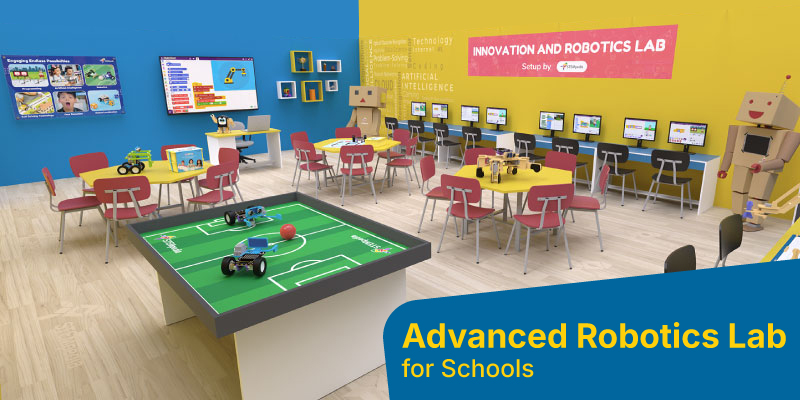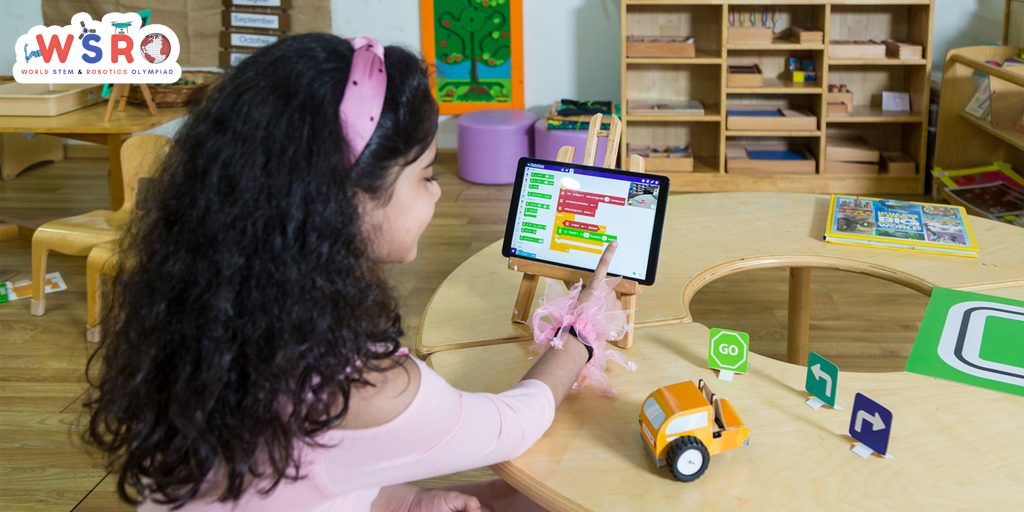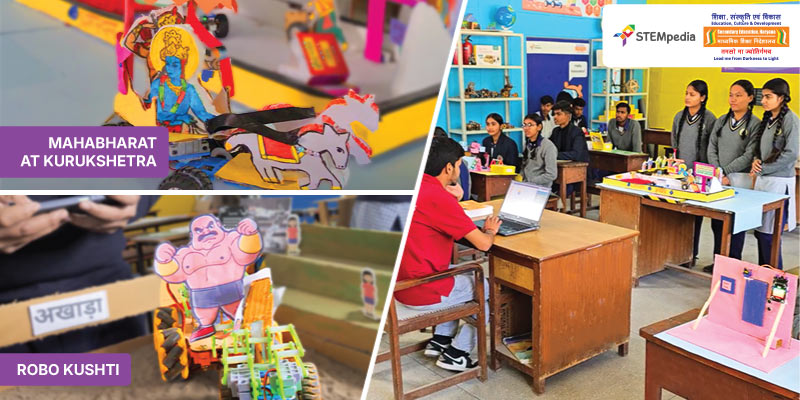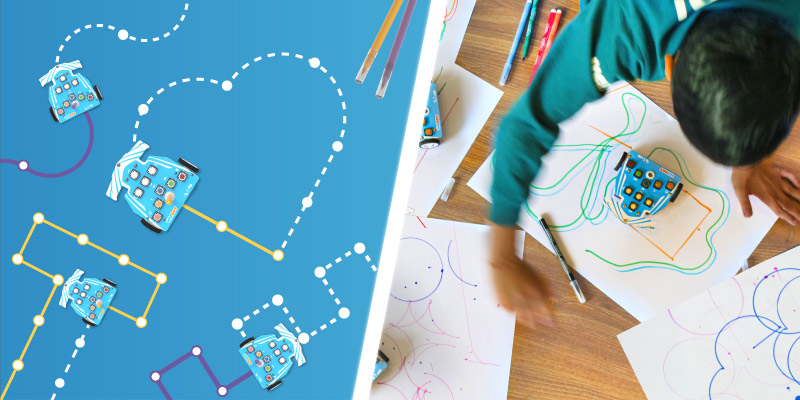Setting up an advanced robotics lab in a school is an exciting opportunity to introduce students to science, technology, engineering, and innovation. The Robotics lab provide hands-on learning experiences, encourages teamwork, and helps students develop essential skills like coding, AI, robotics, and computational thinking. These skills are fun and give students a competitive edge for future careers.
According to a report by the World Economic Forum, 65% of students entering primary school today will work in jobs that don’t yet exist—many of which will be driven by robotics and automation.
With this data in mind, it’s clear that schools should start teaching AI and robotics from an early age. Setting up an advanced robotics lab can help bridge the gap, providing students with the tools and knowledge they need to excel in a rapidly evolving world. Here is a guide to setting up an advanced Robotics lab layout with professional guidance.
Steps to Set Up an Advanced Robotics Lab in Schools
As your school plans to set up a robotics lab, you’ll need a few essential things to start. From choosing the right space and equipment to selecting the proper curriculum and kits, here are five key steps to help you set up an advanced robotics lab for the school:
Step 1: Infrastructure Requirements
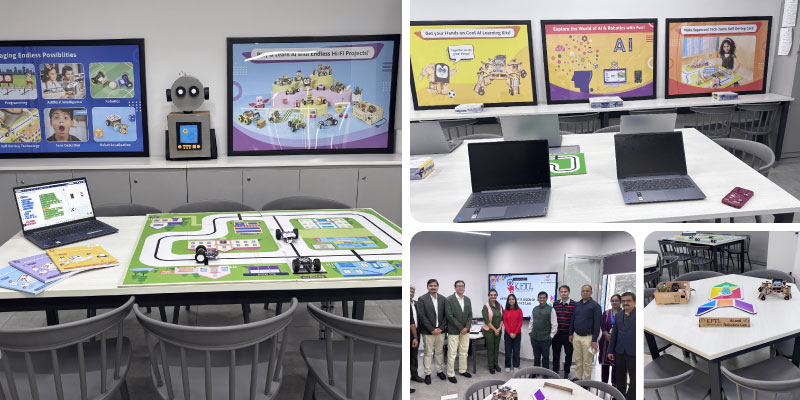
The first and most important step in setting up a robotics lab is having a dedicated space where students can explore AI and robotics concepts. There are two possible scenarios:
- If the school already has space – In this case, you can transform the existing area into a well-designed, engaging environment that encourages students to learn and experiment with AI and robotics.
- If the school lacks space – Some schools may not have a designated area for a robotics lab. Creating a new setup requires careful planning to ensure a functional and inspiring learning space.
No matter the situation, STEMpedia, an AI and Robotics set up company, provides a complete guide on designing an ideal AI lab, ensuring that it meets all requirements.
Essential Infrastructure for Setting up an Advanced Robotics Lab
The lab’s infrastructure should be a valuable asset to the school, providing both functionality and an engaging learning atmosphere. Here’s what an ideal robotics lab should include:
- Spacious Worktables—Large, hexagonal tables where groups of students can comfortably collaborate and work on activities.
- Practice Area—A designated space (such as a practice field) where students can test and refine their robotic projects.
- Essential Tools and Equipment—A well-stocked lab with the necessary tools, robotic kits, and computers.
- Decorative Elements—Frames, posters, and wall art that enhance the AI and robotics vibe, making the lab visually appealing and interactive.
A well-planned robotics lab should have enough space to accommodate workbenches, computers, and storage while allowing free movement for students. Since robotics projects often require larger setups, having an open, well-organized area is crucial.
Step 2: Structured Curriculum for Advanced Robotics Lab
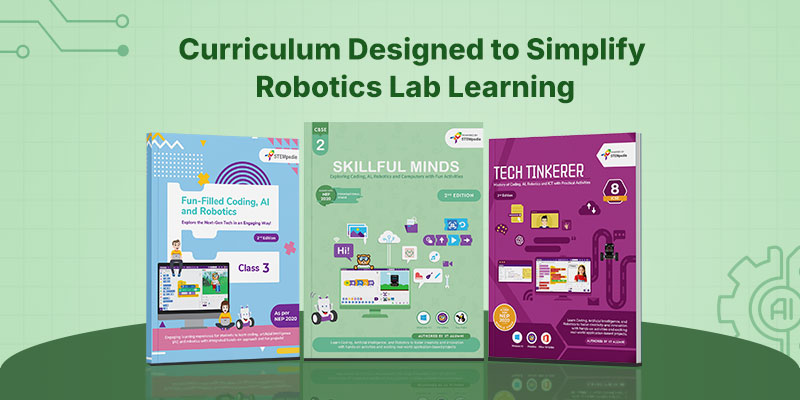
After you’ve solved the question of space for the robotics lab, the next big question is: What will students study? What curriculum should you follow in school for robotics? The answer lies in choosing an AI and Robotics curriculum that aligns with your school’s board.
Integrating robotics into the curriculum is key to preparing students for the future. Ensuring your program follows the right guidelines can help students develop important coding, AI, and robotics skills.
CBSE Aligned Curriculum for ICT, Coding, AI, and Robotics
Ensure that your AI and robotics program aligns with the relevant subject codes, such as 417, which focus on coding, AI, and STEM education. Utilize resources like ICT, Coding, and AI books for classes 1-8 and 9-10 to provide structured, engaging learning experiences.
ICSE Aligned Curriculum for ICT, Coding, AI, and Robotics
Align your curriculum with subject code 66, which covers robotics and AI. Books on ICT, Coding, and AI for classes 1-8 and 9-10 provide hands-on learning and practical exposure to these essential subjects.
AI and Robotics Curriculum for Different Boards
Customize your robotics program to meet your board’s specific academic requirements. Select AI and Robotics books that align with your school’s curriculum guidelines.
Step 3: DIY Robotics Kit for Advanced Robotics Lab Set Up in School
After aligning the curriculum, the next step is deciding on the heart of the robotics lab: DIY Robotics kits. These robotics lab equipment for school are essential for giving students the hands-on experience they need to learn and grow in the field of robotics.
Choosing the right tools to engage students and help them explore their creativity is crucial for a successful robotics lab. This is where Quarky, our DIY Robotics Kit, comes in. Designed specifically for advanced robotics labs, Quarky provides all the necessary hardware components for students to dive into the exciting world of robotics.
Students can start with simple tasks like building robots that follow lines and gradually progress to more complex projects, such as Humanoid Robots that mimic human movements or four-legged robots that can walk and navigate. Students can explore advanced robotics concepts with exciting kits like the Quarky Mars Rover, inspired by NASA’s Perseverance, and the Mecanum Wheel Robot for multi-directional movement.
They can dive into manipulator robotics with the 3 Degree of Freedom Robotic Arm Kit or unleash their creativity with the Quarky Quadruped Kit, coding it to walk, dance, and follow gesture commands. As they advance, students can even experiment with creating Internet of Things (IoT) devices that connect to the Internet.
Step 4: Integrating a Coding and AI Platform in the Classroom
After deciding on the robotics kit, the next important step is choosing the right coding software for classes to customize how your robots work. This is where a coding and AI platform comes in – it’s the backbone of any robotics lab, allowing students to bring their ideas to life.
Pictoblox is a user-friendly, AI-based platform that makes learning coding and AI concepts easy for students in the robotics lab. It helps turn abstract ideas into real-world applications. Here’s how it works:
- Simplified Coding: Pictoblox supports block-based coding, which is perfect for beginners. It also offers Python for more advanced learners, allowing everyone to learn at their own pace.
- AI and ML Projects: Students can explore AI and machine learning concepts through hands-on projects, helping them turn their creative ideas into real-world applications.
- In-Built Tutorials: The platform has built-in examples, making it easy for students to understand and experiment with coding and AI.
- Interactive Learning: Pictoblox allows students to create animations and games, making learning fun and engaging while teaching important programming principles.
Step 5: 360-Degree Teacher Training for Robotics
Now that the Robotics Lab is set up, the next key step is ensuring your teachers are equipped to guide students effectively. Teachers play a vital role in the success of a robotics program. Thus, investing in AI and robotics training is crucial. This prepares them to use robotics kits and teach advanced concepts like AI, python, machine learning, and more. Moreover, helps them conduct engaging sessions using coding platforms like PictoBlox.
This training will equip them with the skills and confidence to support students to thrive in the robotics lab. We offer both on-site and online teacher training programs to cater to your school’s specific needs.
Learning Management System (LMS)
Teaching robotics can be challenging, but an LMS simplifies it with structured lessons, activity sheets, and assessments. STEMpedia’s LMS streamlines the process, saving time and helping teachers focus on guiding students.
Showcasing Advanced Robotics Learning at the International Innovation Fest
With the robotics lab fully equipped, where can students apply their skills?
The answer is International Innovation Fest— Codeavour, where young minds bring ideas to life.
Each year, CODEAVOUR introduces a new theme on global challenges, inspiring students to create AI and robotics solutions. With participants from 60+ countries, it offers a platform to showcase projects on an international stage. It helps in turning classroom learning into real-world impact.
In a Nutshell!
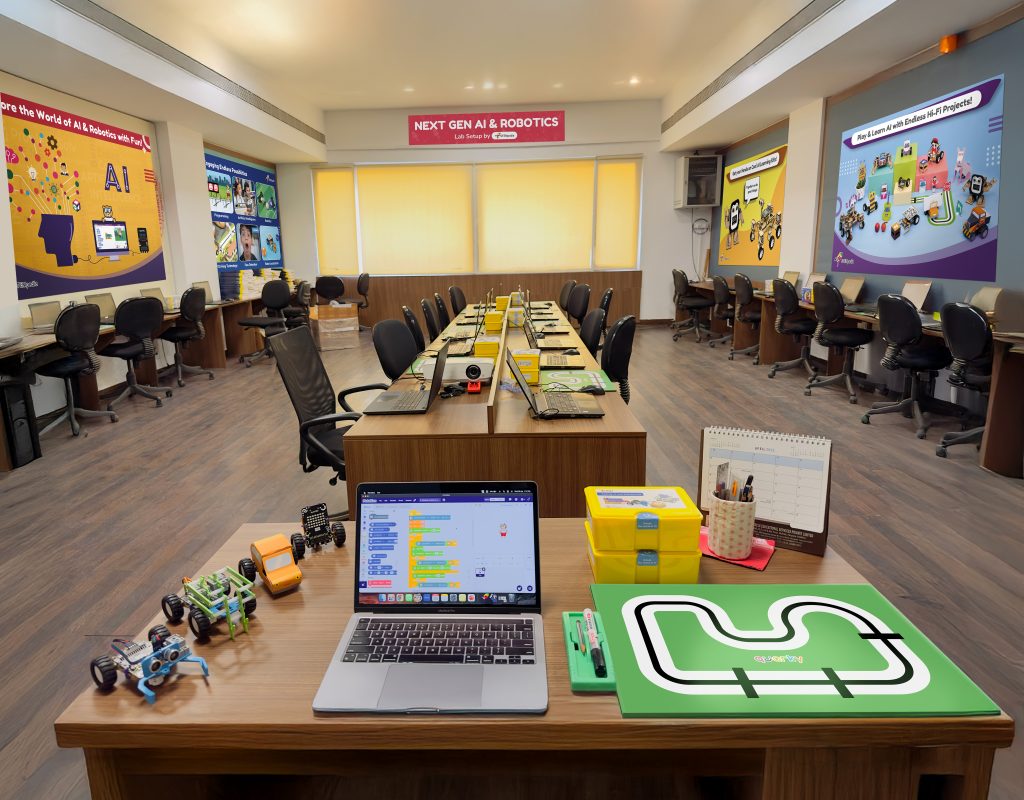
Setting up an advanced robotics lab means creating a well-equipped space, aligning with board standards like CBSE, ICSE, or other boards. While offering kits like Quarky and using coding platforms such as PictoBlox. Teacher training helps educators guide students, while global competitions like Codeavour boost innovation and confidence. Empower your students with a lab built for tomorrow!
To see what your lab will look like, Book a Demo.

